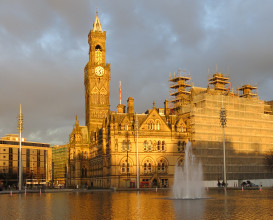 Bradford Town Hall.
Bradford Town Hall.
Bradford City Hall is unique in sculptural terms in having upon its exterior a fairly full sequence of the country s rulers (first England, then Britain) from William the Conqueror through to Queen Victoria. There are nearly 40 statues in all, made by the firm of Farmer and Brindley, and emplaced in 1873. Below are pictures of most of them.
First a few words on the building itself. It was built as the Town Hall (Bradford gained city status only later), by the local architects Lockwood and Mawson, who had something of a stranglehold on major architectural commissions in Bradford for some years. It is Gothic, in 13th Century vein, in the beautiful local stone that so many Bradford buildings are made of and makes it such an atmospheric town. The approach from the station gives good views of the many sided corner, but the best views are from the other side of Centenary Square, or across the round pond. From Centenary Square, then, we see a great long fa ade with central grand entrance, the latter being almost a keep in its own right, with bay window above the doorway, and side turrets rising to pointy towers with a tall gable in between. On either side, seven large bays, each with a double-width Gothic window at first floor level, incorporating two smaller lights and a roundel above; and on the floor above, fourteen windows, in pairs. On the tall roof above, three projecting attic windows, each paired. At each end, taller gables above two further bays. And behind all this frontage, a great central tower, 220 feet high, de rigeur for the grandest town halls. The whole edifice from this side is not quite symmetrical, because of the projecting corner towards Broadway. All the way along are the statues, at second floor height between the paired windows, with four further ones on the central block, of which two flank the doorway and so are well below the others. And the sequence continues round on the left hand side, and a bit on the right hand side. The detailing is good various little spires with crockets on top, repeating little pillars, and so forth, but nothing else naturalistic apart from that long row of statues. There are however projecting gargoyle monsters on the tower, and at the top of the centre-most gable, a standing statue of an angel.
Bradford Town Hall: sculptural details.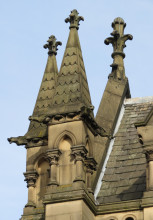
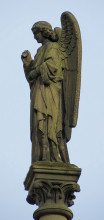
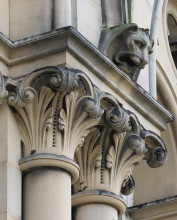
An extension was added at the rear of the building in 1905-9 by Richard Norman Shaw with F.E. P. Edwards, the latter being the municipal architect of the town, and a little bit of undemolished street survives in the centre of the building, complete with a bit of curb.
Now to the statues, which we take in chronological order (noting that a couple are missing from the list below), and mentioning en passant some of the better known other statues of the same rulers which I have seen:
Statues of William I, William II and Stephen.


William the Conqueror (King William I, 1066-1087) is shown with one hand drawing his sword, the other resting upon his Norman shield. He wears the characteristic chainmail of the Norman knight, with a cloak thrown over his shoulders, and his legs with strappings and open sandals almost Saxon in appearance. His body is muscular, and his pose relaxed.
William Rufus (King William II, 1087-1100) by contrast is shown in the robes of a peaceful king. He wears an enveloping cloak above a shirt and loose shift. Like his father, he has a Gallic moustache, and his crown is more impressive.
King Stephen (1135-1154) is another warlike king, in mail, more solid than William the Conqueror has, underneath a tunic, and his legs are in chainmail too above soft, long-toed boots which protrude over the edge of the statue s base. His head is encased in mail hood underneath his crown, and his aspect is fierce and commanding. A fine statue, with nice details, including the belt hooked at his waist.
King Henry II, Richard the Lionheart and King John.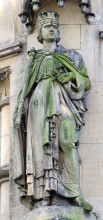

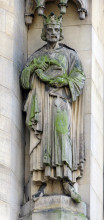
King Henry II (1154-1189) s statue is another robed, peaceful one, with sceptre in one hand, against his shoulder, and the other holding up his robe, Roman senator fashion. The hanging folds are decorated with patters at the hems and edges, and the treatment of the drapery is rather Byzantine, which is appropriate given his dates.
Richard the Lionheart (King Richard I, 1189-1199) is of course another warlike king, in mail again, with gloves, plate over his shins, mail underneath, and robe on top. His hands grasp the hilt of his long sword. The figure and pose is noble, somewhat let down in close-up by the bland face. Statues of Richard I are a subject chosen by several sculptors: the most famous, of course, now standing by the Houses of Parliament, is the equestrian Richard the Lionheart by Marochetti, originally at the entrance of the Great Exhibition of 1851.
King John (1199-1216) is not just in robes, but apart from his crown, looks positively ecclesiastical, with his saintly or Christlike head, the vertical lines of his robes, with one knee pushed somewhat forward, and apart from the position of his hands, could be almost a standing effigy. His hands, though, clasp the half-unrolled scroll with hanging seal of the Magna Carta. There is an effigy of King John on his tomb in Worcester Cathedral, which is likewise ecclesiastical. And a standing statue of King John, rather simple in style, is on the frontage of a building in Kingston upon Thames, in the Market Square; this too shows him holding Magna Carta.
Statues of Henry III, Edward I and Edward II.

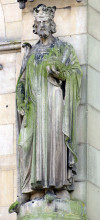
King Henry III (1216-1272) carries a staff in one hand which leans against his shoulder, thus like the Henry II statue above, but is a superior figure, with a finely carved head, depicting a man in late middle age, with craggy, lined face of character and subtlety. His other hand holds a model of a building. He is another robed king, with wide sleeves and a nice pattern of zig zag folds across his chest and stomach. Interestingly, on the exterior of Manchester Town Hall is another statue of Henry III by Farmer and Brindley. The head is similar, and the pose extremely similar, down to the position of the feet on the base. The drapery is different, however, and the building carried by the Bradford Henry III is replaced by the normal orb with crucifix on top in the Manchester statue. There is also something more thin about the Bradford statue, though perhaps this impression comes mostly from the neck.
King Edward I (1272-1307) looks more of a crusader, with mail under his tunic, and robe above. He rests the elbow of one powerful arm, holding a scroll in the hand, upon the wrist of his other hand, which clasps the pommel of his sword. The figure we see is youthful and proud. Another youthful, proud statue of Edward I, again in crusader costume, is to be found in Holborn, high up, and is by the sculptor Richard Garbe. And in Southampton Art Gallery is a small equestrian figure statue of Edward I, rather gaunt of appearance, shield slung upon his back, by Hamo Thornycroft; the large version, though I have not seen it, is apparently in the Guildhall Art Gallery in London.
King Edward II (1307-1327) is another robed, older king, similar in spirit to the statue of Henry III, but less forceful. Along with his staff, he holds a sceptre, the first King to do so.
Statues of Edward III, Richard II and Henry IV.
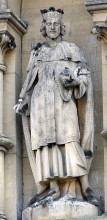
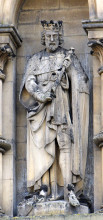
King Edward III (1327-1377). We are back to the statue of the armoured knight, now with plate armour. The king holds a long sword, and a shield, and has at his hip a dagger; his cloak is thrown back rather than covering his shoulders, and his pose is athletic. Farmer and Brindley made another Edward III statue for Manchester City Hall, and the two figures are extremely similar in the style of the head, and the armour that they are wearing, and the dynamism of the pose, though the actual pose is different. Kingston has a statue of Edward III as a more Henry VIII like figure, wide of chest and solid of appearance, with a full beard. A much older statue, of Edward III as an ascetic and monastic figure wearing a crown that looks more like a skullcap, is on the frontage of Canterbury Cathedral.
King Richard II (1377-1399). A very clerical looking portrait statue, wearing an embroidered outer garment which would easily fit a priest, and with a high collar which again is not unlike that worn by a cleric. He holds the orb and sceptre.
King Henry IV (1399-1413). Another robed figure, of more mature years, holding a sceptre in two hands, as if the weight was rather much for him. His tunic under his robe is held above the waist with a tied cord, and he has a bracelet on one arm, and fussily tied shoes. A statue of a younger Henry IV, holding a more slender sceptre, very long, and a parchment with seal, is that by H. H. Armstead in King s College Cambridge, known as the Founder s Fountain statue.
King Henry V, King Henry VI, and King Edward IV .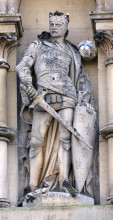

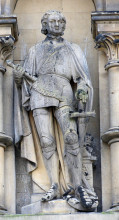
King Henry V (1413-1422). We return to the warrior king, and this is one of the best statues in the series. He stands contrapuncto, one arm resting on his Norman-style shield, the other holding his drawn sword, and looks sternly off to one side. His cloak is thrown back, and the composition puts emphasis on his muscular torso and limbs. The detailing of the armour is good the powerful gauntlets, the shoes with their overlapping metal plates, the designs on the breastplate.
King Henry VI (1422-1461, 1470-1471). The statue shows an austere figure in tight-fitting clothes under a dressing-gown like outer robe, one hand holding a sceptre, the other hand on his hip. His crown looks more like a mitre. The focus of the piece seems mainly on his long right leg. There is a statue of Henry VI in Eton, a strange thing by Francis Bird.
King Edward IV (1461-1470, 1471-1483). The king is shown in plate armour, but has none of the muscularity of the statue of Henry V. One hand rests on the pommel of his sword, the other holds perhaps a scroll. The face is round and not youthful, and he wears no helm, suggesting he is posed in armour rather than likely to fight in it. He does not wear his crown either; it is on a tasselled cushion on a pedestal half behind him; the decoration of the pedestal with a carved olive branch indicates his peaceful rather than warlike intent.
Statues of Richard III, Henry VII, and Henry VIII.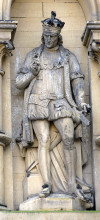
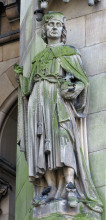

King Richard III (1483-1485). Another statue which stands out in quality. He is shown looking downward, wearing a short tunic above and hose on his legs, and a short robe with fur edging. His left hand is almost clenched, and with his right one he is about to draw his sword, which hangs behind him. There is an emphasis on the muscles of his legs and breadth of his raised forearm to indicate his powerful physique, and coupled with the frowning expression, indicates a forceful king.
Henry Tudor (King Henry VII, 1485-1509). The sculptor has chosen to depict the king as a man of peace and religion, wearing long tunic and robe, holding sceptre and orb, the latter with a prominent cross on top. His expression is bleak, more so than his painted portraits would suggest, his face leathery, and on his head is a soft cap rather than a crown, though a heavy chain with medallion hangs prominently on his breast. Henry Tudor was particularly beloved by the Welsh, and there is a statue of him in Cardiff City Hall by Ernest Gillick. That statue is in full plate armour, and depicts a purposeful man striding to meet, or make, his own fate.
King Henry VIII (1509-1547). The statue shows the famous king rather youthful, not yet so heavy in his body, with a full but not very full beard. His crown is beside him, and he wears a decorated circlet on his head. The bunching up of his outer robe behind him gives structural support as one leg is forward, and leaves a gap behind the other leg, so that there is something of an emphasis on the vigorous figure, made more so by the somewhat jaunty pose of the arms. His position is to the left as we look at the main entrance to the building. There are probably more statues of Henry VIII than any of the other Henry s, and the one that comes to my mind, with a rather similar build to that in Bradford, is the stone one on the fa ade of Canterbury Cathedral. The archetypical Henry VIII statue, with the manner and solidity of the famous Holbein portrait, is that on St Bart s Hospital in London, another work by Francis Bird.
King Edward VI, Queen Mary, and Queen Elizabeth I.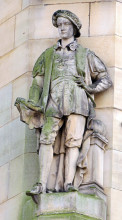
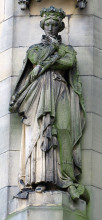

King Edward VI (1547-1553). The companion piece on the other side of the upper portico to Henry VIII. The boy-king stands holding an unrolling charter with seal, his other hand on his hip, wearing tunic, light robes, and breeches tucked into his leggings. On his head is the familiar floppy cap. The statue is not in a niche, and the space to the right of the statue is filled with a square pillar on which rests a globe. In Canterbury is an even more youthful Edward VI statue, too sweet in the face, with chubby youthfulness; a much better one, standing with orb and sceptre, rather sombre, is that by George Frampton, shown at the Royal Academy in 1901, and made for Giggleswick School in Yorkshire.
Queen Mary (1553-1558). The queen is in contemplative pose, head down, leaning gently on one hand; her other hand holds her sceptre across her body. There is a fine sweep to the drapes on the left hand side of the figure.
Queen Elizabeth I (1558-1603). She has pride of place on the lower left of the portico her companion is Queen Victoria, whom we leave to her chronological place at the end of the list. Given the lower position than the other figures, there is more emphasis on the detail of Queen Elizabeth s drapery, which can be appreciated close up. She is a slender figure, looking straight forward and a little towards the entrance, rather than downwards, to give a sense of determination. She has the extravagant ruffed collar that is the trademark of her time, and wears nicely undercut drapery arranged to give an increased sense of movement to the figure. Statues of Queen Elizabeth are to be found in various places. My favourite is in Fleet Street, London, on the fa ade of St Dunstan s Church, showing a youthful queen with rather flat ruff and richly embroidered skirt William Kerwin was the sculptor. A Doulton terra cotta statue of Queen Elizabeth may be found on the frontage of the Hotel Russell in Russell Square. On the Temple Bar Monument is a statue of a queen, popularly supposed to be Elizabeth, by John Bushnell. And of those in other parts of the country, that on Canterbury Cathedral has a less good face, but particularly excellent ruff. Another Farmer and Brindley Elizabeth I statue is on Manchester Town Hall, again with a good ruff, but overall, the Bradford one is the more characterful.
Statues of James I, Charles I, and Cromwell.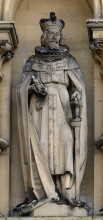

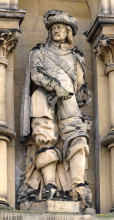
King James I (1603-1625). An archetypical statue of a king, proud in expression, in the prime of life, with mantle and robes, one hand on a scroll, the other on the hilt of his long sword, and wearing a large crown. A rather symmetrical composition, though even here the head is angled somewhat to one side. A rather weird statue of King James I, all pantaloons and leg and contrived pose, is that by Bushnell on the Temple Bar monument in London, now by St Paul s Cathedral.
King Charles I (1625-1649). Recognisable by his little pointed beard and broad moustache, the statue shows the king holding his sceptre in both hands, sword by his side, orb behind him on a pedestal. Charles I is a popular subject for statues. The most famous is that in Trafalgar Square, a noble thing indeed, by the sculptor Hubert le Sueur, and another bust of Charles I, a replacement for one by le Sueur, is on the exterior of the Square Tower near the shore in Portsmouth, instantly recognisable despite being gilded and within a niche. Another bust I have seen is in a niche on Chichester Market Cross, and there is a full statue by Bushnell again, on the Temple Bar monument. In Worcester, there is a statue of Charles I holding a model of a church, on the exterior of the Guildhall.
Cromwell (1653-1658). The series of statues is of rulers rather than simply monarchs, so Cromwell is among the company, with the sculptor making a point about how different in aspect from a king he is the dashing hat, he almost wild-western appearance, the baggy trousers and big boots; one hand holds some crumbled piece of fabric perhaps, the other, behind him, is close to the hilt of his sword. There is a lot of character to this statue, and this with the bulk of the figure gives him a certain extra weight beyond one figure out of well over thirty, suggestive of some sympathy with the concept of Cromwell as a representative of democracy, thus particularly fitting on a town hall, centre of local democracy. The best known statue of Cromwell is the excellent one by Hamo Thornycroft by the Houses of Parliament. John Bell made one of theatrical gesture and clothing for Warrington. A less exciting but still good Cromwell statue is that by Pomeroy in St Ives, Cornwall. And a rather plainly dressed one was made by Matthew Noble for Wythenshawe Park in Manchester.
Statues of Charles II, James II, and William III.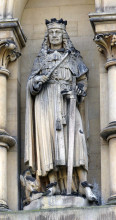
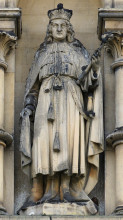

King Charles II (1660-1685). A robed, wigged figure, but of warlike aspect, with his right hand on a tall sword; his other hand carries his staff. He is crowned above long, flowing locks, and his face is rather unsympathetic. Some small dog seems to be resting at his feet, but exfoliation and a liberal splodging of black dirt or paint make it difficult to be sure of the nature of the beast. A most lively statue of King Charles, with large nose and coarse features, and similar wig of many curls, is that by Bushnell on the Temple Bar monument by St Paul s Cathedral in London. And in Worcester, there is a stone statue of Charles II on the exterior of the Guildhall, waving his sceptre and holding an orb, both gilded, this version showing him as an older man. In London is also a statue of Charles II in Golden Square, London, believed to be by John Nost, showing the king as a Roman, in the style of the time. And a wigged one, much mutilated by time, is in Soho Square, being the work of Cibber.
King James II (1685-1688). This statue is not particularly flattering; the king is shown as plump, with round chin, small mouth and petulant lines to his face. In one hand he carries his sceptre, and the other holds the fold of his robe, but so arranged it looks more like a handkerchief. The statue of James II par excellence, of course, is that in Trafalgar Square in front of the National Gallery, which latter is the work of Grinling Gibbons, better known for his wood carving in Wren churches, and shows the king as a Roman emperor in chainmail armour.
King William III (1689-1702). The sculptor has here chosen a dashing pose for the king, half turning towards some foe, reaching across his chest to pull his sword from its scabbard. His hat has two drooping ostrich feathers, and the pose of his head draws attention to the strong nick and the piles of curls along it and over his shoulders. He has tall, extravagant boots, an embroidered waistcoat with oversized cuffs to the sleeves, and wears over all a knee-length cloak which is loosely tied at the side and is swirling open as he turns; a statue of some distinction. His face, though, looks rather unpleasant, which might be the differential wear on the stone, or the build up of dirt, rather than reflecting the balance of features originally given by the sculptor. Behind him, his crown rests on a rock or pillar covered with a cloth. We may note that there are two famous equestrian statues of William III, one in Bristol, by the great sculptor Rysbrack, and one in London, in St James Square, by the elder Bacon (see this page).
Queen Anne, King George I, and King George II.

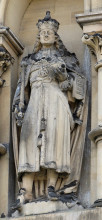
Queen Anne (1702-1714). She is shown as a rather statuesque woman, somewhat past the first flush of youth, with copious hair and a light crown. On her chest she wears a chain of office, and her clothes, including tasselled skirt down below the ankles and upper outer coat, are richly decorated. She carries orb and sceptre. In Worcester, a statue of Queen Anne has her even more solid in physique, also carrying orb and sceptre. Another plump version is in Winchester. The best known Queen Anne statue however is that in front of St Paul s Cathedral, by Richard Belt, after an earlier statue by Bird; the face of this statue and that of the Bradford one are rather similar. In Queen Anne s Gate, London, stands another statue of her, simple in pose but with robes richly decorated in low relief.
King George I (1714-1727). The statue shows him as an older figure, with wavy hair rather than curls, mantle, and robes, carrying an unrolling scroll and his other hand curled into a fist, carrying something indistinct, unless it be no more than the drapes from his robe. The best-known statue of George I is that on top of St George s Church, Bloomsbury, near the British Museum in London. Although that figure is in Roman costume, the rather heavy physique is similar.
King George II (1727-1760). Essentially a symmetrical composition, with the statue of the king staring forward, cloak over his upper arms, tunic divided over his legs. He carries orb and sceptre, and has a sheathed sword behind him. On his chest can be discerned a medal of St George and the Dragon, as also in some of the other statues, but here particularly clearly. The statue contrasts greatly with the image of George II we get from Rysbrack s well-known statue of him in Greenwich, which is of a more slender, more athletic figure in the manner of the noble Romans.
Statues of George III, George IV, and William IV.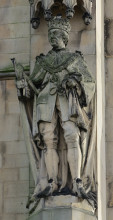

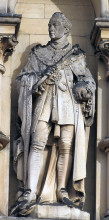
King George III (1760-1820). Another statue with a rather ill-favoured portrait, with lined face, and something of a jowl beneath the too-small mouth. He carries a sceptre on one side, and his other hand, emerging from an enormous sleeve, holds the tassels from a knot at his waist. What a contrast to the noble and Senator-like statue of George III by Chantrey, which stands in Brighton. Different again is the rather strange equestrian George III by Matthew Cotes Wyatt, which stands in Cockspur Street, London, and is shown on this page; a much noble equestrian portrait of that king, very Roman indeed, is that in Windsor Great Park, by Richard Westmacott the Younger. And there is another equestrian George III statue, by Sir Richard Westmacott RA, which stands in Liverpool, in Monument Place. I would also mention one roundel portrait of George III, looking most intelligent, by Bacon the Elder on the frontage of Trinity House, by the Tower of London.
King George IV (1820-1830). Yet one more with an unflattering portrait, short wavy hair, beardless where a beard might have given some shape to the chin, and with a tall collar that emphasises the round head. He carries a sceptre and a book, which rests on a second book on top of a plinth. Again, Chantrey made an equestrian statue of this king, which stands in Trafalgar Square, which is a most excellent thing, and carries off the same tall collar with aplomb. We might mention another roundel portrait of this king, which is on the frontage of nos. 105-109 Oxford Street, London (see about 2/3 down this page).
King William IV (1830-1837). Our penultimate statue is much better, showing the king with decisive expression, and head turned to one side to display the firm jaw. His hair is fairly short, almost Roman style, but an unevenness to the top suggests he has lost some headpiece or crown. He carries orb and sceptre, and his robes are lightly worked with patterns all over. The most well-known statue of William IV, once in the City of London in King William Street, now stands in Greenwich; Samuel Nixon was the sculptor.
Queen Victoria.
Queen Victoria (1837-1901). Jumping back to the main portico, on the right hand side of the entrance opposite Queen Elizabeth I, is Queen Victoria. The statue shows her as youthful, still with slender shoulders, and a blankness of expression which suggests over-cleaning of the stone at some point, which might have been necessary due to decay, as she stands a bit too far forward within her niche for good protection of the head. She carries a small scroll, I think, and her other hand gathers up a portion of the hem of her robe; the hanging folds over her other arm are the best feature of this statue. A variety of Queen Victoria statues are described elsewhere on these pages; the Bradford one is unremarkable.
As noted, Farmer and Brindley were the sculptors. They were a prolific firm, but the comparison which must be made to the Bradford figures are those, already alluded to, on the exterior of Manchester City Hall, less numerous, but in similar vein.
This page was originally part of a 'sculpture of the month' series, for April 2014. Although the older pages in that series have been absorbed within the site, if you would wish to follow the original monthly series, then jump to the next month (May 2014) or the previous month (March 2014). To continue, go to the bottom of each page where a paragraph like this one allows you to continue to follow the monthly links.
Introduction to Bradford // Statues in Victoria Square
Sculpture in England // Sculpture pages
Visits to this page from 1 April 2014: 17,863